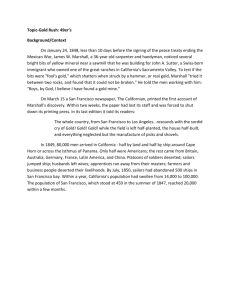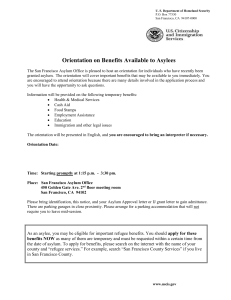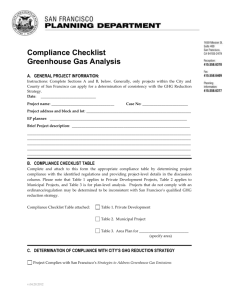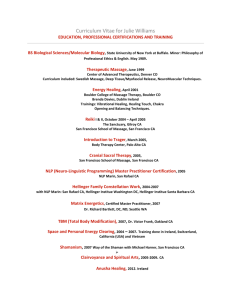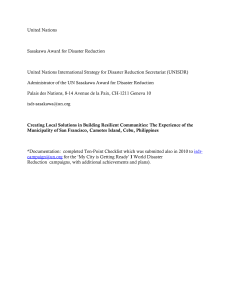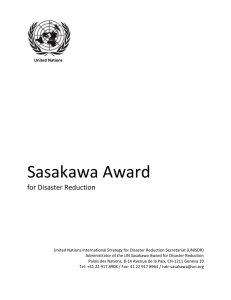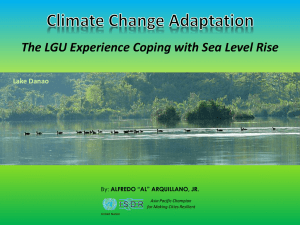of San Francisco Municipality, Camotes Islands, instituted in 2000 a
advertisement
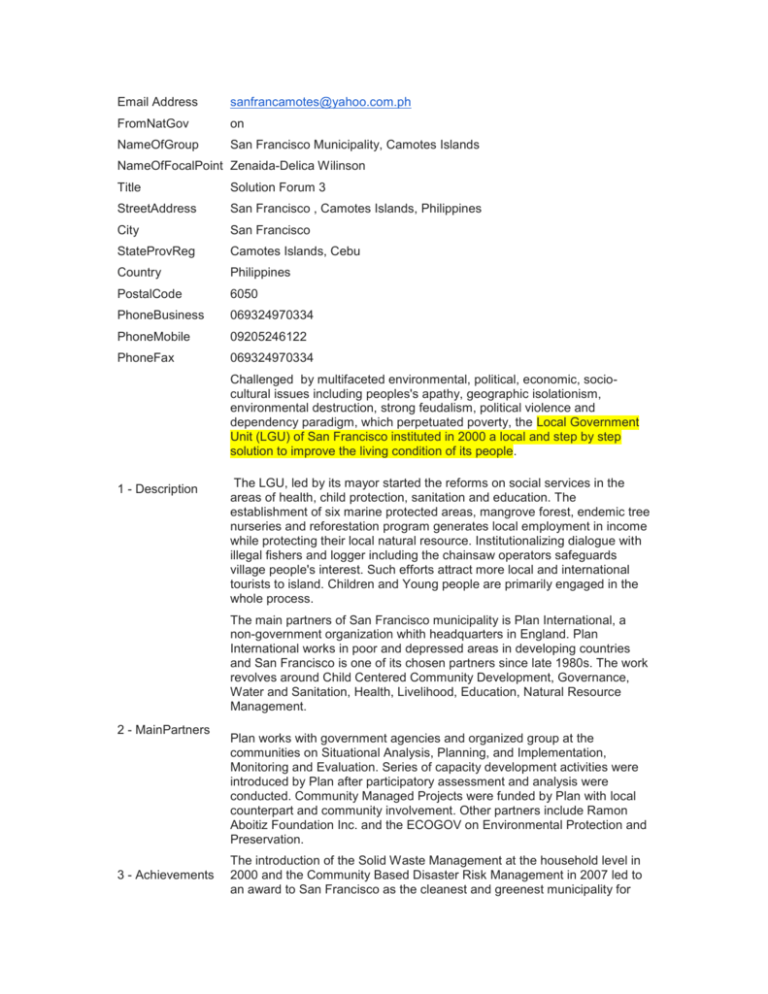
Email Address sanfrancamotes@yahoo.com.ph FromNatGov on NameOfGroup San Francisco Municipality, Camotes Islands NameOfFocalPoint Zenaida-Delica Wilinson Title Solution Forum 3 StreetAddress San Francisco , Camotes Islands, Philippines City San Francisco StateProvReg Camotes Islands, Cebu Country Philippines PostalCode 6050 PhoneBusiness 069324970334 PhoneMobile 09205246122 PhoneFax 069324970334 Challenged by multifaceted environmental, political, economic, sociocultural issues including peoples's apathy, geographic isolationism, environmental destruction, strong feudalism, political violence and dependency paradigm, which perpetuated poverty, the Local Government Unit (LGU) of San Francisco instituted in 2000 a local and step by step solution to improve the living condition of its people. 1 - Description The LGU, led by its mayor started the reforms on social services in the areas of health, child protection, sanitation and education. The establishment of six marine protected areas, mangrove forest, endemic tree nurseries and reforestation program generates local employment in income while protecting their local natural resource. Institutionalizing dialogue with illegal fishers and logger including the chainsaw operators safeguards village people's interest. Such efforts attract more local and international tourists to island. Children and Young people are primarily engaged in the whole process. The main partners of San Francisco municipality is Plan International, a non-government organization whith headquarters in England. Plan International works in poor and depressed areas in developing countries and San Francisco is one of its chosen partners since late 1980s. The work revolves around Child Centered Community Development, Governance, Water and Sanitation, Health, Livelihood, Education, Natural Resource Management. 2 - MainPartners 3 - Achievements Plan works with government agencies and organized group at the communities on Situational Analysis, Planning, and Implementation, Monitoring and Evaluation. Series of capacity development activities were introduced by Plan after participatory assessment and analysis were conducted. Community Managed Projects were funded by Plan with local counterpart and community involvement. Other partners include Ramon Aboitiz Foundation Inc. and the ECOGOV on Environmental Protection and Preservation. The introduction of the Solid Waste Management at the household level in 2000 and the Community Based Disaster Risk Management in 2007 led to an award to San Francisco as the cleanest and greenest municipality for tree consecutive years (2008-2010) at the provincial level. San Francisco used to rank as 2nd in malnutrition rate in the entire Cebu Province. In 2010, Camotes Island became the hall of farmer all throughout the country on community-based health management system. In 2011, San Francisco received the model town award from the Cebu province and the recognized Sasakawa Award from the UNISDR. At the same time, the vice mayor was recognized and awarded as the champion in the resilient cities campaign for Asia and Pacific by the UNISDR. More than 40,000 people in the whole municipality benefit in the building resilience campaign, home based solid waste management and community managed health systems. The local government protect the more than 600 hundred hectares of Danao Lake inside the island, which is a host to local reeds, known as Soli-Soli, a resource for mat weaving bags, and other native decors. The massive plantation and periodic harvest of this resource brings the people a sustainable source of income all throughout the year. Soli-Soli also serves as carbon sequester that offset the islands' carbon emission. It also filters and prevents soil erosion. San Francisco has Soli-Soli Festival every year that attracts tourists and income. Danao Lake is adjudged as the second cleanest lake in the Philippines. It's where the biggest endemic tree nurseries are found whose wildlings are taken from the natural trees at the lake sides. Community and home based wilding collections for the nursery stockss also generate income espacially for the school children during weekends and vacation time. With the integration of Disaster Risk Reduction and Climate Change Adaptation with Solid Waste Management and Community Based Health Systems, San Francisco, Camotes introduces the concept of Climate Smart Disaster Risk Management. It then becomes the learning hub in the province. Neighboring provinces tour to San Francisco with international visitors to learn the evolving practices on community resilience. The local authorities and its partners are spreading the good news trough local southsouth exchange, forums, radio guesting and capacity development. 4 - Sustainability Development plan is based from the municipality's vulnerability and risk assessments. The budget on Disaster Risk Reduction and Management and Climate Change Adaptation was legislated and approved for five years. Other development budget reinforces the DRR and CCA Fund. Continuing Education in schools and public awareness in the communities bring sustainable mechanisms and ensure that communication reaches the farthest members of the Purok Systems. "Think Big Tart Small" is the unique formula for San Francisco. Believing in the capacity of household members, children, the olds, farmers, fishers, gardeners, teachers, men and women, environmentalists and capacitating local talents and champions in the different sectors of the municipality is a key for development. 5 - Innovation 6 - Replicability The Purok System is established in each village. It has an organizational structure and functions. It maintains data and information from each member household. It has a library, vegetable and herbal gardens, risk maps, capital build up and material recovery facility for the solid waste management. The Thematic Priorities of the Hyogo Framework for Actions are translated into the local language, which helps the local people in building community resilience. Its simplicity is the main reason why it can be adopted, replicated and scaled up. The following are some ingredients that make it easy to replicate: updating community risk assessments results, participatory planning, recognition of contributions, localization and simplification of development jargons, inclusion of children and youth; making the Department of Education as the learning hub; qualitative interventions and feedback sessions, continuing training and other capacity development activities. a. Job creation: Now there is less cases of local migration due to local crop plantation that is climate proof. After years of protecting local resource, fishermen's catch improve and no longer travel deep seas. Natural Resource Management brought job through weaving, nursery management, wilding collections and tree planting and growing for fee. Community based tourism through home stay and local food consumption; and trained Emergency Response Team, which could be hired in the local beach resorts for life guarding; brought income to household. b. Income-generation: see above c. Infrastructure development: Typhoon proof market structures, installation of the Solar Power to Purok that are not energized yet. Small water impounding construction, protect farmers from invasions. d. Education: Establishment of Children and Women protection unit, campaign on anti-human trafficking, joint scholarship program, community and school based health management systems. 7 - Contribution e. Social inclusion: Purok System observes the principles of inclusion. f. Outreach: Media, Network establishment local and international, theater training, developing youth media correspondence.. learning visits and host inter LGU training on resilience. g. Networks: Social Networks, Print, Broadcast, local, national and international ties with the govt and UN Bodies, linking the church and other religious groups, local and international businessmen. h. Environment: polution mitigation, minimization or combating of poaching of wildlife, etc. launched 2million tree project, Ridge to Reef Approach, San Francisco as Eco Town pilot model. i. Global Health: Solid Waste Management, Malnutrition addressed immediately, organized local health ambassadors... j. Agriculture and Food security: Climate Proof products - establishing green houses - MPA's vegetarian food campaign having the vice mayor as the model... 8 - Awareness Where possible, send copies of the actual articles as an annex - video, websites availables and other necessary links. 9 - Other See attached document
